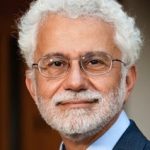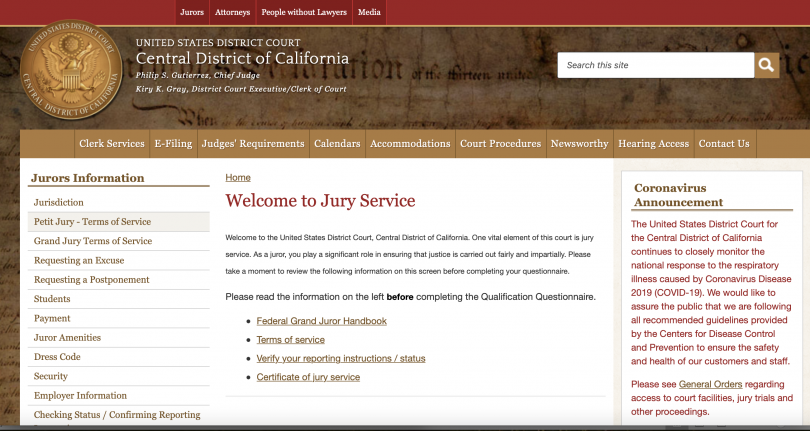by Peter A. Joy
Editor’s note:
When former Los Angeles County sheriff Lee Baca, former undersheriff Paul Tanaka, and other members of the LASD were being investigated for obstruction of justice, and conspiracy to obstruct justice having to do with their part in the 2011 attempt to derail a federal criminal probe into corruption and brutality inside LA County’s jail system, those of us who were trying to figure out who might be indicted and when, got our best clues as to what charges might be upcoming by learning who was testifying in front of the federal grand jury convened for the purpose of the investigations, and what kind of questions witnesses were being asked.
Since we’re hearing a lot about grand juries having to do with January 6, and other efforts to overturn the 2020 presidential election, we figured you’d be interested in this short course in the use of grand juries by Professor Peter A. Joy of the Washington University School of Law in St Louis, who is expert on the topic.
So read on!
The use of grand juries, state and federal
Grand juries play a major role in the U.S. criminal justice system. And they’re very much in the news these days.
A grand jury in Fulton County, Georgia, is looking into former President Donald Trump’s efforts to overturn the 2020 presidential election results in that state. Among the latest witnesses to give testimony to the grand jury was Georgia Gov. Brian Kemp.
In Washington, D.C., the U.S. Justice Department is in the middle of an investigation into efforts to overturn the 2020 election, and it is questioning witnesses before a grand jury as well. Most recently, two top aides to former Vice President Mike Pence were questioned in that probe.
A grand jury does not mean that the investigation will lead to any formal criminal charges, which are known as indictments. There was a grand jury that issued subpoenas during the investigation into Hillary Clinton’s email server, for example, but no one was charged with any crimes.
In order to understand grand juries and their work, I offer the following explanation of how federal and state grand juries are used in the U.S.
Legal basis: Federal and state
The Fifth Amendment to the U.S. Constitution provides the legal basis for grand juries. In federal criminal cases, federal grand juries are made up of 16 to 23 members. They decide whether to indict someone who is being investigated, and at least 12 grand jurors need to agree to issue an indictment.
In addition to considering whether individuals may have committed a crime, a grand jury can also be used by a prosecutor as an investigative tool to compel witnesses to testify or turn over documents. Reports indicate that Special Counsel Robert Mueller used a grand jury for the latter when he investigated whether there was collusion between former President Donald Trump’s election campaign and Russia to influence the 2016 election.
Makeup of a grand jury
Grand jurors are usually chosen from the same jury pool as trial jurors. For a federal grand jury, all U.S. citizens over the age of 18 living in the federal district court’s geographic jurisdiction are in the pool.
Court clerks first identify members of the grand jury pool from public records, including records of licensed drivers and registered voters.
Next, prospective grand jurors are screened, usually through questionnaires.
To be a member of a federal grand jury, a person has to be adequately proficient in English, have no disqualifying mental or physical condition, not be currently subject to felony charges punishable by imprisonment for more than one year and never have been convicted of a felony (unless civil rights have been legally restored). The court then randomly chooses candidates for the grand jury from this pool.
Work of the grand jury
In all felony cases, there must be a “probable cause determination” that a crime has been committed in order for a case to move forward to a trial or a plea. “Probable cause” means that there must be some evidence of each element of the offense.
In the federal system, a grand jury is the body that makes the probable cause determination. In many states, like Missouri, the probable cause determination can be made either by a grand jury or at a preliminary hearing before a judge.
When there is an option for either a grand jury or preliminary hearing to determine probable cause, the prosecutor decides which one to use. For example, in the shooting death of Michael Brown by police officer Darren Wilson in 2014, the St. Louis County prosecuting attorney brought the evidence to a grand jury rather than choosing to present evidence to a judge through a preliminary hearing. In serious cases like murder, most prosecutors use the grand jury because it is usually quicker than a preliminary hearing.
Most people whose cases go to the grand jury have already been arrested. These include all of the cases in which a person is arrested while committing a crime or shortly after the crime has been committed.
In some cases, prosecutors do not have all the evidence they need to make a good case. In these investigations, a grand jury is used to help with the investigation. Once the grand jury is impaneled, the prosecutor has the ability to subpoena records and witnesses.
Subpoena power means the prosecutor can compel witnesses to turn over documents and to testify. If the prosecutor obtains sufficient evidence of a crime, the same grand jury has the power to indict whomever it believes has committed a crime.
The work of a grand jury is required by law to be done in secret, so the public has no right to know who is subpoenaed or what documents the grand jury is reviewing. Even though the grand jury work is secret, federal rules and a majority of states permit grand jury witnesses to discuss what occurred when they testified.
In some high-profile cases, witnesses subpoenaed to appear before the grand jury will talk to the press if they think it will be helpful to them. For example, when former President Bill Clinton testified before a grand jury during the investigation into Whitewater real estate investment and the affair with Monica Lewinsky, he went on national television and announced that he had testified.
Potential dangers
The secrecy of a grand jury presents some dangers. The defendant does not know the evidence being considered, does not have a right to be present, and cannot question the evidence early in the criminal justice process.
As a result of the secrecy, the grand jury can also end up being a tool of the prosecution, and the prosecutor can choose to withhold evidence that is favorable to the accused. That is why a former chief judge of the New York Court of Appeals, the highest court in New York, famously said that a prosecutor could get a grand jury “to indict a ham sandwich.”
These types of dangers are always present during any grand jury, and getting a grand jury to issue an indictment may be easy. But in high-profile cases, like the Russia connection to the Trump presidency and possibly the current investigation into Trump’s efforts to overturn the election results in Georgia, proving wrongdoing beyond a reasonable doubt through a trial or a negotiated guilty plea usually proves much more difficult.

Author Peter A Joy, is the Henry Hitchcock Professor of Law at the Washington University in St Louis School of Law where he supervises student-lawyers who provide direct legal representation to clients and work with experienced public defenders on criminal matters. Professor Joy has written extensively and presented nationally and internationally on legal ethics, lawyer and judicial professionalism, clinical legal education, and access to justice issues. He is a recipient of the Association of American Law Schools’ (AALS) Pincus Award for outstanding contribution to clinical legal education, and is a member of the ABA Section of Legal Education and Admissions to the Bar’s Accreditation Committee; and a former executive committee member of the Association of American Law Schools (AALS) Professional Responsibility Section, which he chaired in 2011.
Professor Joy’s essay first appeared in The Conversation.


The president’s efforts likely violated a federal law making it . The principles provide convenient reference points for the process of making prosecutorial decisions; they facilitate the task of training new attorneys.
This system may be good to get the Sheriff and BOS back on track or possibly sent to jail!
Maybe it’s time to have the Grand Jury in LA do an investigation to see if they need to open an investigation on the Sheriff’s Depts operation and call the right people to appear re gangs and other matters that need to be cleared up before the election
https://www.latimes.com/california/story/2022-08-08/grand-jury-sheriffs-department
https://mobile.twitter.com/LACoSheriff/status/1556805724847497216/photo/1
LA Times Headline: Sheriff’s Dept. under fire as trial starts over Kobe Bryant crash photos https://www.latimes.com/california/story/2022-08-09/kobe-bryant-crash-photos-vanessa-sheriff-department-lawsuit-trial
LASD Under Fire? How about, The LASD has been On Fire ever since inept Alex and Sweatpee took over the reigns. Now, all of Alex’s idiotic scandals are starting to hit the courtrooms and juries. Hold on to your wallets folks, as the VILLANueva train wreck is going to cost hundreds of millions by the time all of his FUBARS are said and done.
We can’t get rid of this fool and his clown car of Actors and Skippers soon enough. Future Sheriff Luna might find the LASD is beyond repair when he is sworn in come this December.
Adios Alex & Sweatpee
Why does the LA Times bloc out articles that have been posted or are on the inner net? with there ads either make the e-mails open or remove the ads
https://spectrumnews1.com/ca/la-west/public-safety/2022/08/10/judge-sets-expedited-contempt-hearing-for-sheriff-villanueva
Former L.A. County assistant sheriff sues Sheriff Villanueva over demotion
https://www.cbsnews.com/losangeles/video/former-los-angeles-county-assistant-sheriff-sues-villanueva/
https://mobile.twitter.com/JonnyPeltz/status/1557478757522292736?cxt=HHwWgICq9bKro50rAAAA
Let’s start an “office pool” type survey on WLA.
Anyone care to to predict how many times inept Alex will invoke the 5th amendment once he is finally questioned under oath? Whoever comes closest without going over wins!
I’ll start it off with (28) times.
Adios Alex & Sweatpee
I don’t doubt it. It’s that, and the high likelihood voters will perceive that tactic as guilt, or dig yourself deeper with adding perjury to the obstruction charge sheet.
He’s cornered like the crook he is.
I’ll wager 18 pleas.
https://coc.lacounty.gov/
I’ll say 17